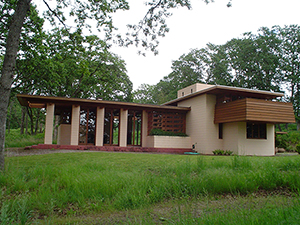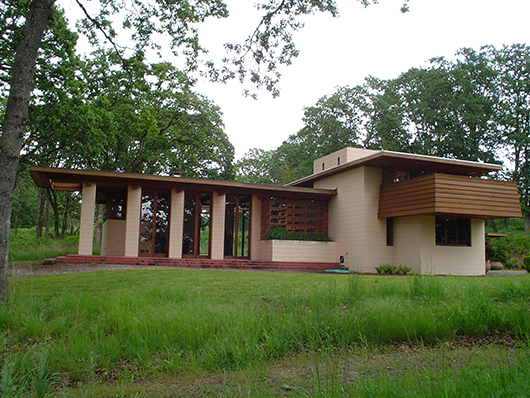
The Gordon House in Silverton, the only Wright building in Oregon and the only one of his residences open to the public in the Pacific Northwest, has towering walls and plenty of clean-lined spaces that serve as perfect backgrounds for captivating contemporary art.
The concrete-and-wood house, designed by Wright in 1957 for Evelyn and Conrad Gordon, was built from 1963 to 1964 on the Gordons’ farm on the Willamette River near Wilsonville. In 2002, the dwelling was dismantled and moved next to the Oregon Garden.
Evelyn was a weaver and artist who saw her home as an accommodating sequence of galleries to display her paintings, prints and sculptures.
Original paintings, many by Northwest artists, hung on every wall, including in the kitchen where cinder blocks rose 15 feet to meet a skylight.
She had Native American weavings, a metal sculpture by James Shull and – sharing Wright’s passion for Japanese art – a Haku Maki woodblock print.
Roger Hull, curator emeritus of the Hallie Ford Museum of Art in Salem, is helping the nonprofit Gordon House Conservancy reacquire Evelyn’s collection and return it to her beloved home.
One of her pieces, a Charles Heaney oil painting, prompts Hull to say that Wright and Heaney, who moved to Portland as a teenager, were both inspired by the American West and its spacious landscapes that allowed for an interplay of architecture and nature.
Until the collection is reassembled here, art appreciators can view changing exhibits. The upcoming “Wright Angles . . . Home is Where the Art is” features two dozen oil paintings, caricatures and cartoons by Larry Kassell of Silverton.
Like Heaney, Kassell is attracted to relics, from derelict homes and barns to rusty trucks and tractors.
Kassell’s original works will be exhibited from Aug. 3 through Sept. 1 at the Gordon House, 869 W. Main St., Silverton. An artist’s reception will be held from 5 to 8 p.m. Aug. 9.
The exhibit can be viewed for $5 from noon to 3 p.m. every day except Tuesday when the historic house is closed. Guided tours are $15.
In another exhibit, Roycrofter artisan CJ Hurley of CJ Hurley Century Arts will present his collection of paintings paired with poetry in the Gordon House Living Room Gallery Sept. 6-28. There will also be a reception Sept. 13 for “Houses, Landscapes, Flowers & Dreams, The Poetic Art of CJ Hurley.”
Year-round, art appreciators can sit the in the built-in library seating and take in Wright’s well-preserved creation, which is listed on the National Registry of Historic Places.
Wright was an artist before he was an architect, says Molly Murphy, the Gordon House executive director, “and colored pencils were his famously favorite medium.”
He produced a colored pencil rendering of buildings he designed, including the Gordon House, that represented his vision of the project after an introductory interview with the client.
The original renderings are protected at the Taliesin West archives and his original pencil set is part of the collection at his home and studio in Spring Green, Wis. But the Gordon House sells a 9-inch-by-26-inch art print of the residence’s rendering onsite and on-line for $20.
Wright also enjoyed sketching the flora and landscapes of the natural world, adds Murphy. “He called these his Nature drawings. Some of his fans refer to them as the ‘weed sketches.’”
She continues: “His organic architecture concepts marry the building to the site as though they were always meant to be together. The Gordon House is a wonderful example of this at both its original and current location.”
Wright collected art, especially Japanese prints, which he sold off to support his lifestyle when money was scarce. To help tell this story, Murphy says the Gordon House displays traditional Hiroshige and contemporary Haku Maki artwork.
___
Information from: The Oregonian, http://www.oregonlive.com
Copyright 2014 Associated Press. All rights reserved. This material may not be published, broadcast, rewritten, or redistributed.
AP-WF-08-02-14 1102GMT
ADDITIONAL IMAGE OF NOTE



